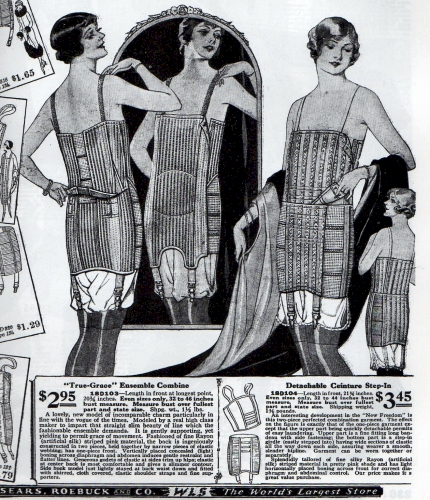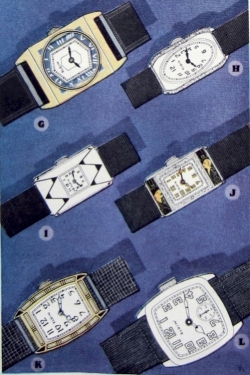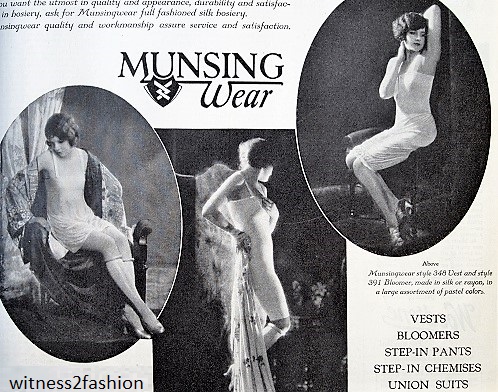
Detail from and ad for Munsingwear knit undergarments, Delineator, September, 1927.
Frau Buttonbox asked what women wore under those 1920’s dresses in the winter — and how they protected their dresses from sweat and body oils. I have some ads to share!
Just for vocabulary, in the U.S., a one piece knit suit like this was called a “union suit” (proper name) or “long johns” (common name.)
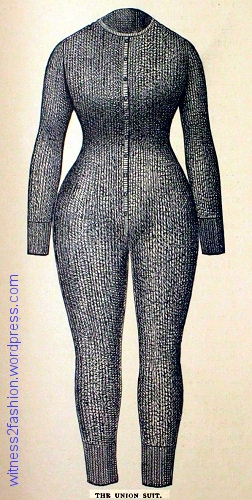
This wool union suit was recommended by dress-reformer Annie Jenness-Miller in 1888.
In 1880’s England, Dr. Jaeger’s theory that wearing wool next to the skin (instead of plant fibers like linen or cotton) was good for health was championed by dress reformers and George Bernard Shaw.
My uncle Bert (like Garrison Keillor’s “Norwegian Bachelor Farmers”) came from a generation (b. 1899) that believed that a hot bath would “open your pores” to admit disease, so he wore long johns from September to March. My stepmother insisted that he wash them (and himself) from time to time if he wanted to eat dinner with us. Whew!
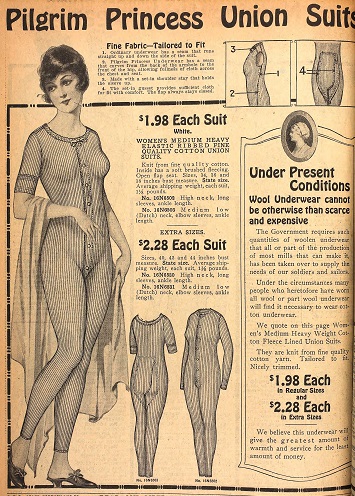
Women’s union suit from Sears catalog, Fall 1918.
By 1916, skirts were getting shorter, but lace-up boots would have hidden the legs of this underwear. Notice the short sleeves.
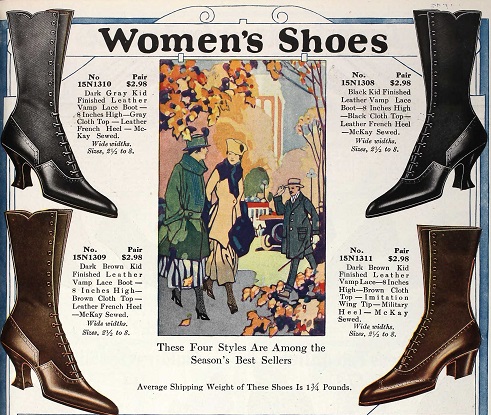
Ladies’ shoes from Sears catalog, 1918.
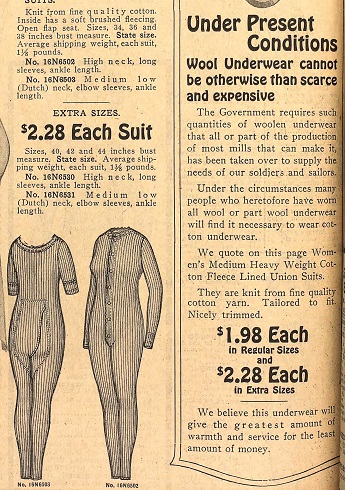
Wool, needed for army uniforms, was hard to get in the U.S. in 1917-1918. Note the overlapping “open” back.
The problem with fashionable clothing is that it is usually the opposite of practical clothing — so women who want to be fashionable usually have to sacrifice some comfort — and common sense.
By the mid-1920s, skirts were reaching the knee, and bare arms were expected with evening dresses and dinner dresses. Nevertheless, many dining rooms (even in mansions) were unheated.

Ad for Forest Mills long underwear, Delineator, November 1925. The union suit on the left could be worn under day dresses. These models look like teens.
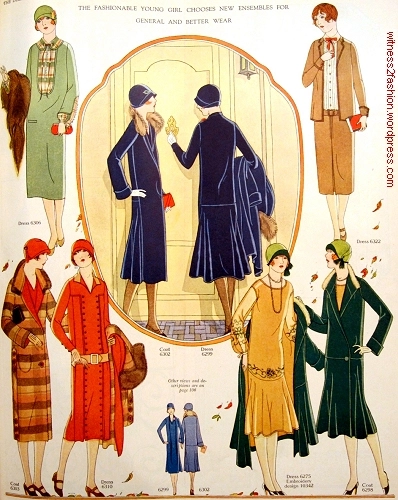
Winter clothes for teens and small women, October 1925. Delineator.
Under evening dress, your torso could be warm, but your arms had to be bare.
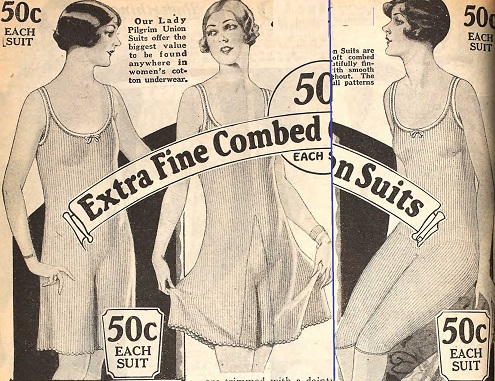
Combed cotton knit underwear from Sears, 1927 catalog. You could wear a silk or rayon slip over these, under your dress.
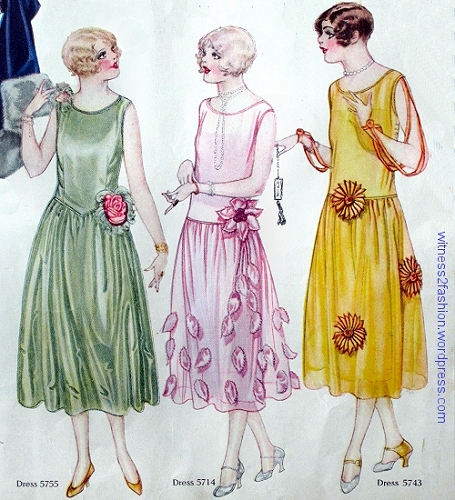
Evening dresses for teens, January 1925.
“It s no longer necessary to shiver through the long winter months in order to be stylishly dressed.”
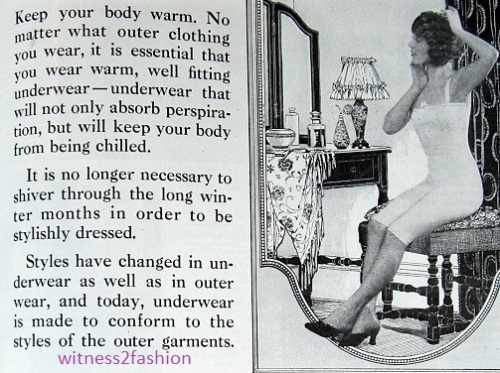
“Keep your body warm.” Ad for Forest Mills knit underwear, Delineator, November 1925. The ad doesn’t state fiber content, but knits made for a smooth, “no bumps” fit.
“Underwear that will not only absorb perspiration, but will keep your body from being chilled.”
The Forest Mills underwear shown in the photograph is not much different in style from silk underwear (slips, camisole and bloomers) sold by Sears, but knit underwear fit more smoothly.
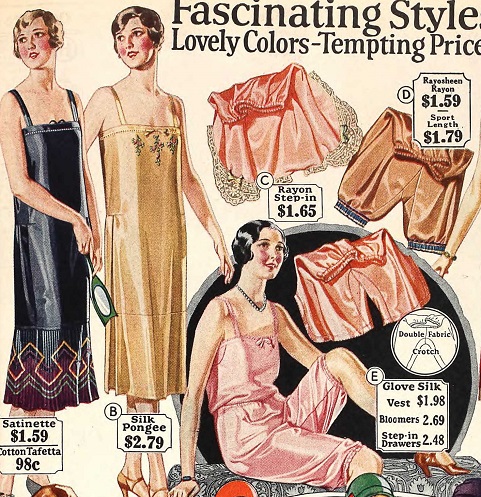
Silk underwear from Sears catalog, Fall 1927. Silk or rayon bloomers came to just above the knee.
Carter’s, a company that made rayon knit underwear, ran a whole series of ads that showed couture fashions next to pictures of models (in the same poses) wearing Carter’s underwear. I don’t now how warm it was, but it did fit very closely.
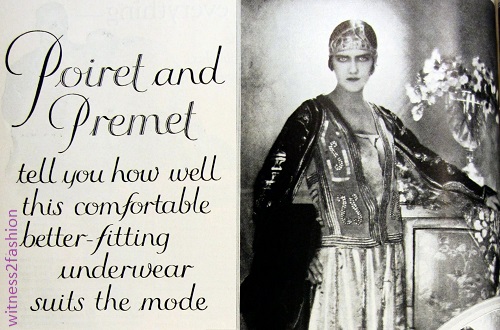
Detail of an ad for Carter’s rayon knit underwear, Delineator, November 1926. Premet and Poiret were famous Paris Couturiers. That’s a Poiret model above.
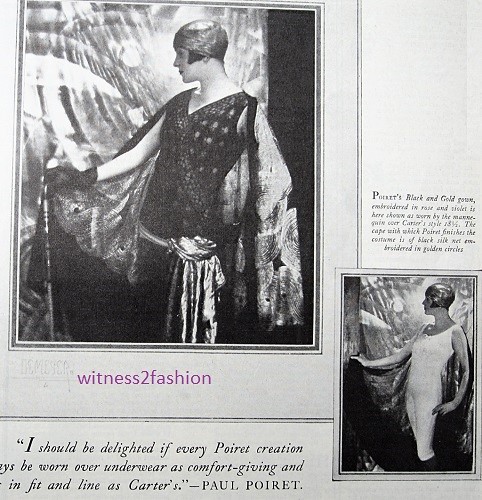
Detail of 1927 ad for Carter’s underwear. The model wears Poiret; at right she poses in her Carter’s underwear.
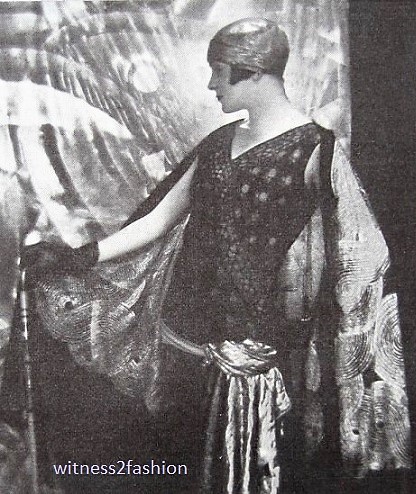
“Poiret’s black and gold gown” and silk cape, pictured in an ad for Carter’s underwear, November 1927. Poiret was very influential in the 1910’s, but falling out of favor by the late 1920’s.
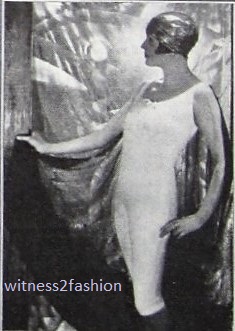
Detail from an ad for Carter’s knit underwear, November 1927. Smooth, one-piece fit.
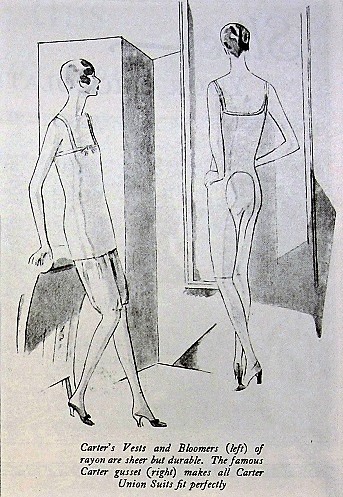
Right, back view of a one-piece union suit; left, a camisole “vest” and bloomers. Carter’s rayon knit undergarments, ad from 1926.
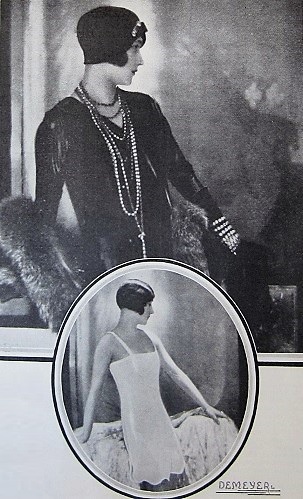
Premet’s “Vampire” dress, with Carter’s combination underwear to go under it. April, 1928. That dress would have permitted a much warmer undergarment.
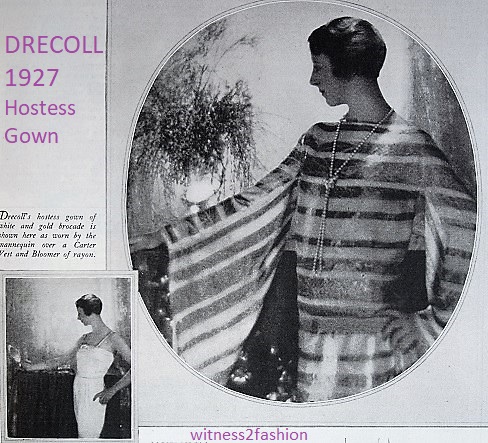
The gold and white brocade hostess gown is by Drecoll; the underwear is Carter’s “vest and bloomer” of rayon knit. Ad from May 1927. The House of Worth also participated in this ad campaign.
As to keeping clothes free of perspiration stains and odor, deodorants were available (and ruined the armpits of many a vintage garment….) A solution still used in theatrical costumes, and by those allergic to certain chemicals, is the dress shield.
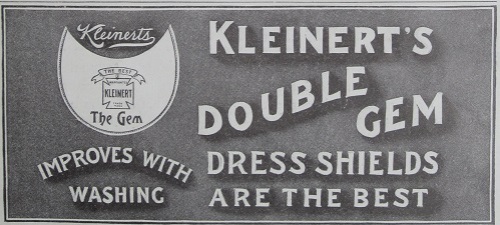
1910 ad for Kleinert’s dress shields. Delineator.
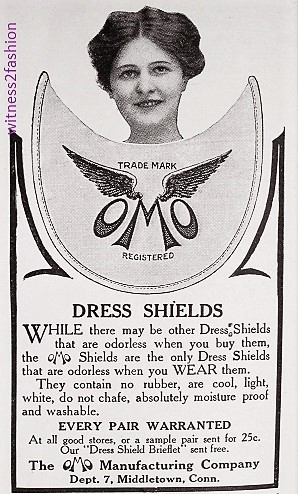
Ad for OMO dress shields, a rival to Kleinert’s. March 1910, Delineator.
Dress shields were usually safety pinned or basted into place in the armholes of a dress or jacket.
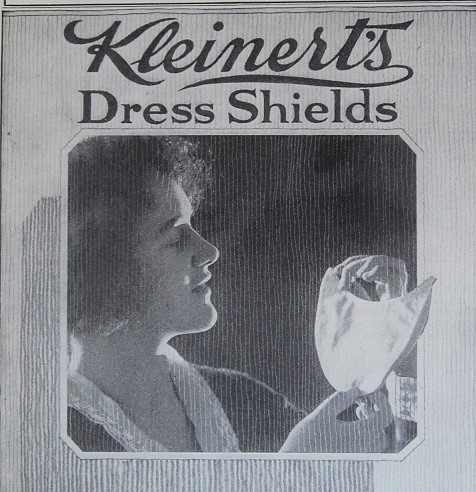
1920 Kleinert’s dress shield ad. You can see that this shield is curved at the top to follow the shape of the bottom of the armhole; it folds over the underarm seam, extending into the dress and into the sleeve.
Costumers sew in snaps so the shields can be changed and washed. Some women preferred to wear a bra or guimpe-like washable garment which included the shields.
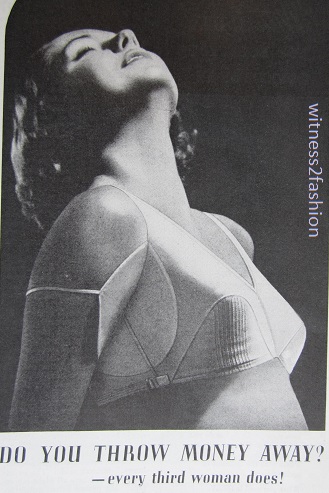
Top of a Kleinert’s dress shield ad, Woman’s Home Companion, March 1937.
The Kleinert’s website (the company is still in business) explains:
“Before The Advent Of Deodorants & Antiperspirants The Dress Shield Was The Way To Protect Your Garments From Sweat & Odor. In 1869 Kleinert’s Invented the Dress & Garment Shield Category Which Is Still In Use Today Protecting Our Clothes & Saving Us From Embarrassing Situations Due To Sweat Stains & Odors. Trust Kleinert’s Quality & History To Keep You Dry Throughout The Day. Choose Below From Our Selection Of Fine Dress Shields.” Kleinerts.com
The shields come in different shapes for differently cut armholes. Now you can get disposable ones — and in a costume emergency I have cut self-adhesive pantiliners to stick in the underarms of a costume.
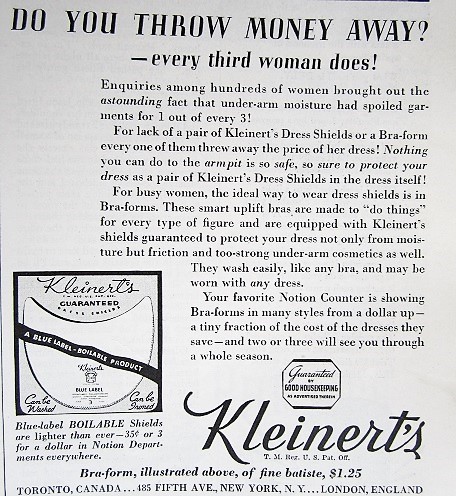
Bottom of Kleinert’s dress shield ad from March 1937, WHC.
I’ve mentioned this before: actors sweat, and stage actors have to wear their costume(s) for eight performances per week. It’s not good for a wool suit to be dry-cleaned every week; underwear protects the costume, but a changeable shield under each arm keeps the suit from getting wet at all. Undershirts and shirts, etc., are laundered daily — in fact, Equity actors have duplicates supplied so they don’t ever have to put on a shirt that is still damp from the matinee performance. (Ditto for all other items that touch the skin.)
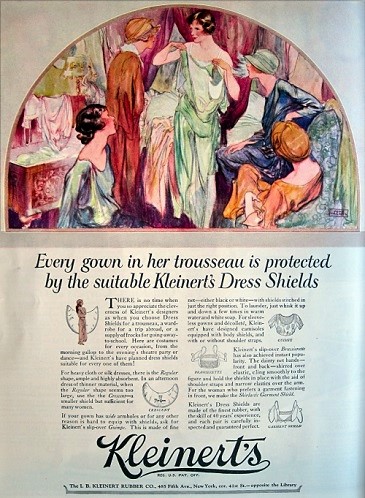
Full page, full-color Kleinert’s ad, March 1924. Delineator.
Unsexy as a dress shield may be, it’s preferable to ruining a $2000 dress or destroying it by too-frequent dry cleaning. Bonus: you can raise your arms and never show a sweat ring.
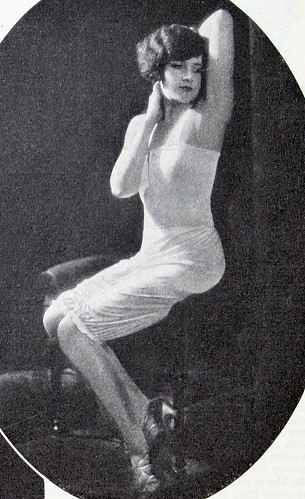
Camisole and bloomers from Munsingwear ad, September 1927, Delineator.
P.S. [Edited 1/6/2019] Liza D at BVD sent a photo of the Kleinert’s dress shields she found in a vintage garment (Thanks, Liza!) :
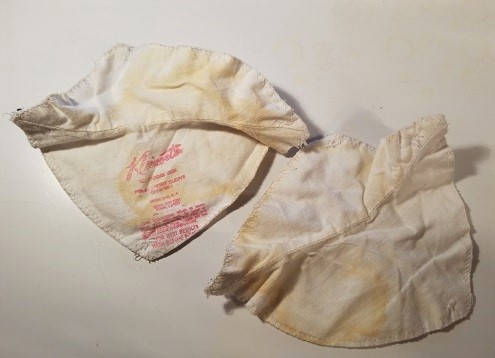
Liza D found these used dress shields in a vintage garment. Those ugly stains would have been on the blouse if the woman who wore it hadn’t used these in the underarms. Click here for Liza’s post about it.




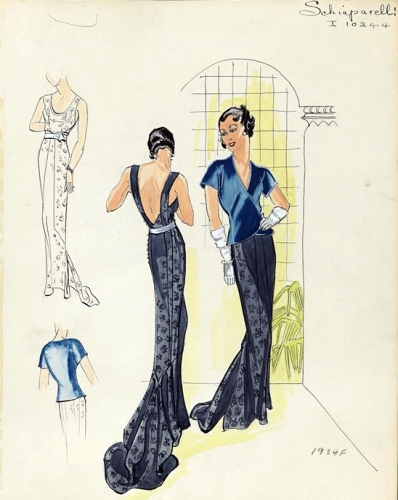

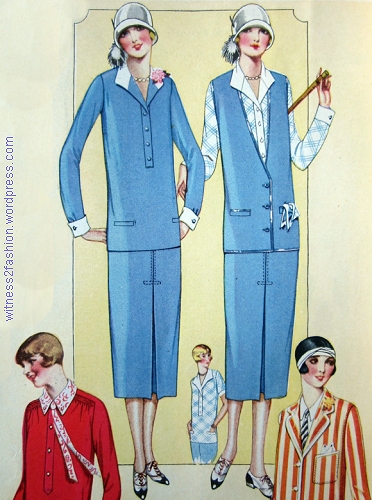


![1916 designs by Gabrielle Channel [sic] from Doris Langley Moore’s Fashion through Fashion Plates, cited by Quentin Bell.](https://witness2fashion.files.wordpress.com/2014/07/chanel-1916-bell-plate-39-from-fashion-through-fashion-plates-doris-langley-moore.jpg?w=500)







